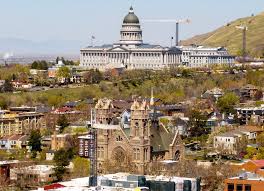Utah has earned the top spot in U.S. News & World Report’s Best States rankings for the third consecutive year in 2025. The Beehive State shines because of its strong economy, political cooperation, and community-focused values. But how does Utah continue to top the list? Let’s explore the top 7 reasons why Utah remains America’s best state in 2025.
🏆 1. Utah’s Unmatched Economic Stability

In 2025, Utah remains a powerhouse in the economy category, ranking #3 in the nation. The state boasts a diverse and growing economy, with key industries like technology, energy, and healthcare. Utah also enjoys a low unemployment rate and an affordable cost of living relative to other tech-heavy states like California. According to CNBC, Utah’s job growth and fiscal policies make it one of the most attractive states for business.
Strong fiscal policies and a balanced budget have earned Utah the top spot for fiscal stability. As economic experts point out, Utah’s ability to generate revenue without compromising long-term growth ensures that its residents have access to high-quality services.
🙏 2. The Role of Religion in Shaping Utah’s Values

The influence of the Church of Jesus Christ of Latter-day Saints (LDS Church) is deeply embedded in Utah’s culture and governance. While only 42% of Utahns now identify as members of the LDS Church, its principles still shape the state’s values. Many policies, particularly in education and welfare, are driven by a sense of community and shared responsibility.
Dr. Paul Reeve, a historian at the University of Utah, notes that the state’s “community-first” mentality, rooted in faith, helps Utahns weather economic storms and social challenges together. The Deseret News covers how the LDS Church continues to influence community development in the region.
💰 3. Fiscal Responsibility and Economic Growth
Utah consistently performs well in fiscal responsibility and economic growth, boasting a diversified economy. The state has been able to fund essential programs while keeping taxes low. This results in high quality of life for its residents, coupled with minimal state debt. As a result, Utah residents benefit from a robust social safety net without excessive taxation.
🏛️ 4. Bipartisan Politics and Cooperation
Unlike other U.S. states, Utah excels in bipartisan politics. With a relatively small population and a shared understanding of the need for pragmatic solutions, state lawmakers consistently work across party lines. State leaders, including Senator Wayne Harper (R) and Senator Stephanie Pitcher (D), are known for prioritizing effective policies over partisan gridlock. Utah’s political culture promotes finding common ground, which has contributed to its strong governance model. For further insights into Utah’s bipartisan politics, see the article from UtahPolicy.
💼 5. Strong Infrastructure and Public Services
Utah is a leader in infrastructure, ranked #3 for infrastructure in 2025. This ranking is due in part to its investment in transportation networks, clean energy, and digital infrastructure. Additionally, the state’s public services, such as education and healthcare, are consistently ranked among the best in the nation. Utah’s emphasis on sustainability and future-proofing its infrastructure ensures that it remains an attractive place for families and businesses alike.
🏠 6. Affordable Housing and Quality of Life
While housing prices have increased due to population growth, Utah still ranks favorably for affordability compared to high-demand states like California. The state has taken steps to address housing challenges by implementing policies that encourage growth while ensuring that it remains affordable for middle-class families. The Silicon Slopes tech boom has also provided job opportunities without driving up living costs excessively. For more on housing policies in Utah, check out The Salt Lake Tribune article.
🌟 7. Utah’s Education System and Future Opportunities
Education remains a priority in Utah, where the state ranks #4 for education in 2025. From K-12 education to higher education institutions like the University of Utah, the state has made significant investments in its education system. These investments ensure that Utah’s next generation is well-prepared to lead in a rapidly changing global economy. The Utah Valley University is at the forefront of educational innovation, offering leading programs in STEM fields.
Conclusion
Utah’s success in 2025 proves that a combination of faith, fiscal responsibility, bipartisan cooperation, and a focus on community values creates a thriving environment. While challenges remain, particularly in housing affordability and environmental concerns, Utah’s performance across key metrics ensures it will continue to lead in the years to come.
Utah’s model is one of measured progress—balancing economic growth, cultural values, and political cooperation. It remains a shining example for other states looking to thrive in an increasingly complex world.
Related Articles: Why Texas Struggles Despite Economic Growth









